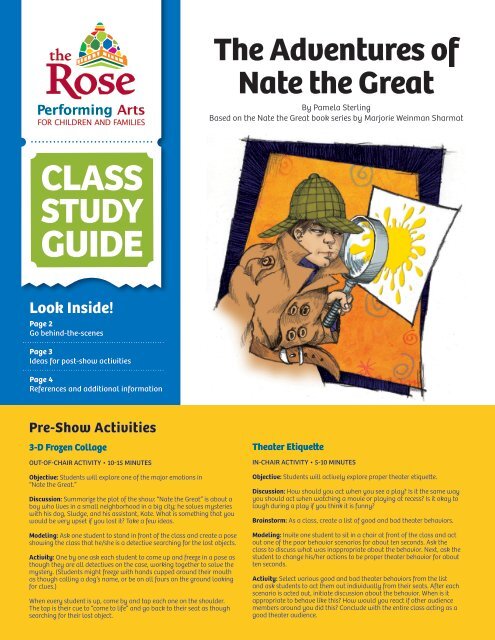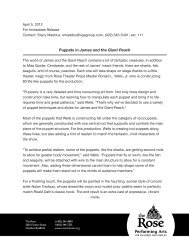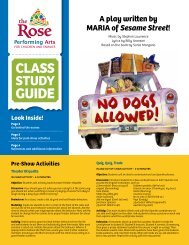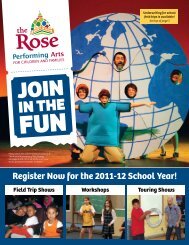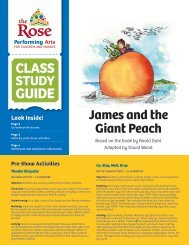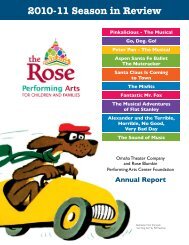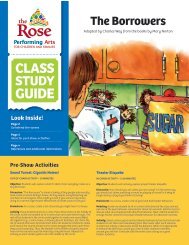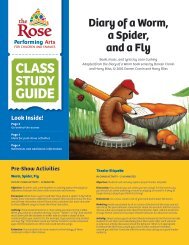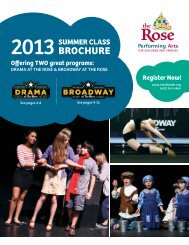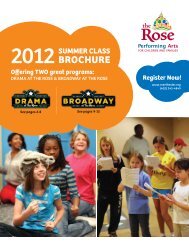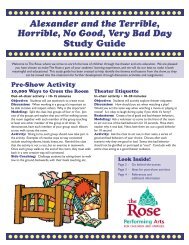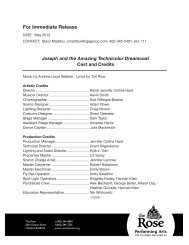The Adventures of Nate the Great - The Rose
The Adventures of Nate the Great - The Rose
The Adventures of Nate the Great - The Rose
You also want an ePaper? Increase the reach of your titles
YUMPU automatically turns print PDFs into web optimized ePapers that Google loves.
<strong>The</strong> <strong>Adventures</strong> <strong>of</strong><br />
<strong>Nate</strong> <strong>the</strong> <strong>Great</strong><br />
By Pamela Sterling<br />
Based on <strong>the</strong> <strong>Nate</strong> <strong>the</strong> <strong>Great</strong> book series by Marjorie Weinman Sharmat<br />
CLASS<br />
STUDY<br />
GUIDE<br />
Look Inside!<br />
Page 2<br />
Go behind-<strong>the</strong>-scenes<br />
Page 3<br />
Ideas for post-show activities<br />
Page 4<br />
References and additional information<br />
Pre-Show Activities<br />
3-D Frozen Collage<br />
OUT-OF-CHAIR ACTIVITY • 10-15 MINUTES<br />
Objective: Students will explore one <strong>of</strong> <strong>the</strong> major emotions in<br />
“<strong>Nate</strong> <strong>the</strong> <strong>Great</strong>.”<br />
Discussion: Summarize <strong>the</strong> plot <strong>of</strong> <strong>the</strong> show: “<strong>Nate</strong> <strong>the</strong> <strong>Great</strong>” is about a<br />
boy who lives in a small neighborhood in a big city; he solves mysteries<br />
with his dog, Sludge, and his assistant, Kate. What is something that you<br />
would be very upset if you lost it? Take a few ideas.<br />
Modeling: Ask one student to stand in front <strong>of</strong> <strong>the</strong> class and create a pose<br />
showing <strong>the</strong> class that he/she is a detective searching for <strong>the</strong> lost objects.<br />
Activity: One by one ask each student to come up and freeze in a pose as<br />
though <strong>the</strong>y are all detectives on <strong>the</strong> case, working toge<strong>the</strong>r to solve <strong>the</strong><br />
mystery. (Students might freeze with hands cupped around <strong>the</strong>ir mouth<br />
as though calling a dog’s name, or be on all fours on <strong>the</strong> ground looking<br />
for clues.)<br />
When every student is up, come by and tap each one on <strong>the</strong> shoulder.<br />
<strong>The</strong> tap is <strong>the</strong>ir cue to “come to life” and go back to <strong>the</strong>ir seat as though<br />
searching for <strong>the</strong>ir lost object.<br />
<strong>The</strong>ater Etiquette<br />
IN-CHAIR ACTIVITY • 5-10 MINUTES<br />
Objective: Students will actively explore proper <strong>the</strong>ater etiquette.<br />
Discussion: How should you act when you see a play? Is it <strong>the</strong> same way<br />
you should act when watching a movie or playing at recess? Is it okay to<br />
laugh during a play if you think it is funny?<br />
Brainstorm: As a class, create a list <strong>of</strong> good and bad <strong>the</strong>ater behaviors.<br />
Modeling: Invite one student to sit in a chair at front <strong>of</strong> <strong>the</strong> class and act<br />
out one <strong>of</strong> <strong>the</strong> poor behavior scenarios for about ten seconds. Ask <strong>the</strong><br />
class to discuss what was inappropriate about <strong>the</strong> behavior. Next, ask <strong>the</strong><br />
student to change his/her actions to be proper <strong>the</strong>ater behavior for about<br />
ten seconds.<br />
Activity: Select various good and bad <strong>the</strong>ater behaviors from <strong>the</strong> list<br />
and ask students to act <strong>the</strong>m out individually from <strong>the</strong>ir seats. After each<br />
scenario is acted out, initiate discussion about <strong>the</strong> behavior. When is it<br />
appropriate to behave like this? How would you react if o<strong>the</strong>r audience<br />
members around you did this? Conclude with <strong>the</strong> entire class acting as a<br />
good <strong>the</strong>ater audience.
A Behind-<strong>the</strong>-Scenes<br />
Spotlight on Stage Managing<br />
An interview with <strong>Rose</strong> <strong>The</strong>ater<br />
Resident Stage Manager Dani Taylor<br />
<strong>The</strong> <strong>Adventures</strong><br />
<strong>of</strong> <strong>Nate</strong> <strong>the</strong> <strong>Great</strong><br />
By Pamela Sterling<br />
Based on <strong>the</strong> “<strong>Nate</strong> <strong>the</strong> <strong>Great</strong>” book series<br />
by Marjorie Weinman Sharmat<br />
Artistic Team<br />
Director................................James Larson<br />
Scenic Designer.................Mark Parrott<br />
Lighting Designer..............Carson Gross<br />
Costume Designer.............Sherri Geerdes<br />
Properties Master..............Ronald L. Wells, Jr.<br />
Stage Manager..................Dani Taylor<br />
Cast<br />
<strong>Nate</strong>, a great detective......Andy Saladino<br />
Kate, <strong>Nate</strong>’s assistant........Sara Kaus<br />
Sludge, <strong>Nate</strong>’s dog.............Aaron Mann<br />
Annie....................................Amanda Waldron<br />
Harry....................................Andrew McGreevy<br />
Rosamond...........................Lauren Krupski<br />
Claudia................................Kate Morgan<br />
Oliver....................................Tim Siragusa<br />
Finley....................................Brian Guehring<br />
Pip.........................................David Ebke<br />
Esmeralda...........................Amanda Kibler<br />
Fang, Annie’s big dog........Joshua J. Mullady<br />
Produced by special arrangement with<br />
Dramatic Publishing, Woodstock, IL.<br />
Dani joined <strong>The</strong> <strong>Rose</strong> this season as <strong>the</strong> Resident Stage Manager. She recently came <strong>of</strong>f <strong>the</strong> road<br />
from touring for <strong>the</strong> last five years, where she worked on <strong>the</strong> National Tours <strong>of</strong> “Bye Bye Birdie,”<br />
“Altar Boyz,” “Cabaret,” and “Sesame Street Live! Elmo’s Healthy Heroes!” Dani is originally from<br />
<strong>the</strong> Chicago suburbs and is a graduate from Purdue University and very excited to be back in <strong>the</strong><br />
Midwest working at <strong>The</strong> <strong>Rose</strong>.<br />
Q: What does a stage manager do?<br />
A: A stage manager helps organize and communicate during rehearsals and performances.<br />
During rehearsals <strong>the</strong>y help keep track <strong>of</strong> actors blocking, lines, props, and o<strong>the</strong>r technical<br />
aspects that will be needed for <strong>the</strong> performance. During performances <strong>the</strong>y make sure that<br />
everything happens in <strong>the</strong> right order. <strong>The</strong>y use a headset to communicate to <strong>the</strong>ir crew to<br />
prompt lights, sound, set changes, as well as make sure <strong>the</strong> performance is <strong>the</strong> exact same<br />
every time.<br />
Q: What training does stage manager need?<br />
A: Depending on what type and level <strong>of</strong> stage management you would like to pursue,<br />
<strong>the</strong>re are a few training options. You can look into being an Assistant Stage Manager for a<br />
community <strong>the</strong>ater or school performance to learn about <strong>the</strong> process. If you find you enjoy<br />
it and are interested in making stage management your career, you can find a <strong>the</strong>ater<br />
program at a College or University that has a focus in Stage Management.<br />
Q: What made you want to become a stage manager?<br />
A: I became involved in a community <strong>the</strong>ater in my hometown out in <strong>the</strong> Chicago suburbs<br />
when I was 12. I was able to take classes and learn about <strong>the</strong> different aspects <strong>of</strong> <strong>the</strong>ater.<br />
While in high school, I got involved in <strong>the</strong> technical side and had a chance to stage<br />
manage. I <strong>the</strong>n decided that stage managing was <strong>the</strong> part I really enjoyed and pursued it<br />
in college.<br />
Q: What is your favorite part <strong>of</strong> stage managing?<br />
A: I enjoy being able to watch <strong>the</strong> whole process from early designs and concepts, rehearsals,<br />
all <strong>the</strong> way to <strong>the</strong> final product. It’s great to be a part <strong>of</strong> a collaborating team and see <strong>the</strong><br />
final production. I also enjoy <strong>the</strong> possibility <strong>of</strong> <strong>the</strong> unknown. Many unplanned events can<br />
take place during a live performance and it keeps you on your toes!<br />
Q: What is <strong>the</strong> most difficult part <strong>of</strong> stage management?<br />
A: Sometimes in rehearsals we can lose focus and get <strong>of</strong>f track. While it’s mostly fun, I<br />
usually am <strong>the</strong> one who has call us back to order and keep us moving forward.<br />
Q: What is your favorite part <strong>of</strong> <strong>Nate</strong> <strong>the</strong> <strong>Great</strong>?<br />
A: I enjoy when <strong>Nate</strong> and Fang meet for <strong>the</strong> first time!<br />
Explore <strong>the</strong> Job <strong>of</strong> a Stage Manager<br />
Tape It Out!<br />
OUT-OF-CHAIR ACTIVITY • 20-25 MINUTES<br />
Objective: Students will be to collaborate to create a floor plan for a location from “<strong>Nate</strong><br />
<strong>the</strong> <strong>Great</strong>.”<br />
Discussion: A stage manager has many jobs. One important job is that he/she must tape out <strong>the</strong><br />
floor <strong>of</strong> <strong>the</strong> rehearsal room before <strong>the</strong> actors come to rehearsals. This means he/she lays tape<br />
down on <strong>the</strong> floor to indicate walls and platforms that will be used on stage so <strong>the</strong> actors will<br />
know <strong>the</strong> layout<br />
Activity: In small groups, students will decide which location from <strong>the</strong> “<strong>Nate</strong> <strong>the</strong> <strong>Great</strong>” show<br />
<strong>the</strong>y will create. Each group will be designated a section <strong>of</strong> <strong>the</strong> classroom. Using masking tape<br />
or items from <strong>the</strong> classroom, each group will transform <strong>the</strong>ir area <strong>of</strong> <strong>the</strong> room into a rehearsal<br />
hall for that scene.<br />
2 STUDY GUIDE<br />
Sidecoaching: Remind students about what is needed in that scene. Encourage <strong>the</strong>m to listen to<br />
each o<strong>the</strong>r’s ideas and incorporate all ideas into <strong>the</strong> final product.
Post-Show Activities<br />
Smartest Pet Contest<br />
IN-CHAIR ACTIVITY • 30-40 MINUTES<br />
Objective: Students will be able to use visual and performing arts<br />
toge<strong>the</strong>r to create <strong>the</strong>ir own Smartest Pet Contest.<br />
Discussion: What pets did <strong>the</strong> characters in “<strong>Nate</strong> <strong>the</strong> <strong>Great</strong>” have? What<br />
special talents did <strong>the</strong>ir smart pets showcase? What o<strong>the</strong>r pets can you<br />
have? Encourage students to think <strong>of</strong> pets people might not commonly<br />
have (like Oliver’s eel). What can a pet do to show that it is smart?<br />
Activity: Ask every student to choose one smart pet to create. Make<br />
your own sock puppet pet just like <strong>the</strong> ones in <strong>the</strong> show! Use an old sock<br />
and cut out felt, fun foam and fabric to add ears, paws, teeth, a tongue<br />
and more. You can glue on google eyes to finish your puppet. Encourage<br />
students to name <strong>the</strong>ir pet and to make additions that will show <strong>of</strong>f<br />
its intelligence.<br />
Extension: As a class, hold your own Smartest Pet Contest. Each student<br />
will get a chance to perform with <strong>the</strong> puppet he or she created. <strong>The</strong> class<br />
can also work toge<strong>the</strong>r to create a “Smartest Pet” prize.<br />
Make a Mystery to Solve<br />
OUT-OF-CHAIR ACTIVITY • 20-30 MINUTES<br />
Objective: Students will be able to use clues and reasoning to find objects.<br />
Discussion: How does a detective solve a mystery? What tools do<br />
detectives need to do <strong>the</strong>ir jobs? How do <strong>the</strong>y use <strong>the</strong>se tools?<br />
Preparation: Hide an object that is meaningful to <strong>the</strong> class somewhere in<br />
<strong>the</strong> school. Create clues and obstacles that will lead <strong>the</strong> students to <strong>the</strong><br />
hiding place.<br />
Activity: Tell <strong>the</strong> class that <strong>the</strong> object has gone missing. Ask students to<br />
look around <strong>the</strong> classroom to find clues. Working toge<strong>the</strong>r as a class, go<br />
on a scavenger hunt around <strong>the</strong> school that will eventually lead to <strong>the</strong><br />
final hiding place <strong>of</strong> <strong>the</strong> object. This can be especially fun if <strong>the</strong> faculty,<br />
staff, and even o<strong>the</strong>r students know about <strong>the</strong> hunt. <strong>The</strong>y can help give<br />
clues to your students.<br />
Create a Living Storybook<br />
OUT-OF-CHAIR ACTIVITY • 10 MINUTES<br />
Objective: To use imagination and bodies as acting tools, and also to<br />
review <strong>the</strong> play.<br />
Discussion: <strong>The</strong> actors used <strong>the</strong>ir bodies to create different scenes during<br />
<strong>the</strong> play. <strong>The</strong>y also used <strong>the</strong>ir imaginations to tell us a story. How can<br />
we use our bodies and imaginations to retell <strong>the</strong> story <strong>of</strong> “<strong>Nate</strong> <strong>the</strong> <strong>Great</strong>”?<br />
Remember, we’re going to have to work toge<strong>the</strong>r to tell this story.<br />
Activity: Review <strong>the</strong> story <strong>of</strong> “<strong>Nate</strong> <strong>the</strong> <strong>Great</strong>” with <strong>the</strong> students. Discuss<br />
how <strong>the</strong>y can break up <strong>the</strong> story into five parts. What happens in <strong>the</strong><br />
beginning? What next? How about <strong>the</strong> middle? After that? And how<br />
does <strong>the</strong> story end? Divide <strong>the</strong> class up into two groups. Tell <strong>the</strong>m <strong>the</strong>y<br />
are going to retell <strong>the</strong> story <strong>of</strong> “<strong>Nate</strong> <strong>the</strong> <strong>Great</strong> “with five frozen pictures,<br />
like a storybook. <strong>The</strong>y must decide which characters or set pieces <strong>the</strong>y<br />
are in each picture. Remember, <strong>the</strong> students don’t have to be <strong>the</strong> same<br />
characters in each picture. How can <strong>the</strong>y tell <strong>the</strong> story without moving<br />
or speaking? <strong>The</strong>n have <strong>the</strong> groups show <strong>the</strong>ir “storybooks” to each o<strong>the</strong>r.<br />
Have <strong>the</strong> group who plays <strong>the</strong> audience guess what is happening in each<br />
picture.<br />
Mmmm...Pancakes<br />
IN AND OUT-OF-CHAIR ACTIVITY •25-30 MINUTES<br />
Objective: Students will use <strong>the</strong>ir art and acting skills to create and<br />
experience tasting <strong>the</strong>ir own delicious, one-<strong>of</strong>-a-kind pancakes!<br />
Discussion: During <strong>the</strong> course <strong>of</strong> <strong>the</strong> play <strong>Nate</strong> constantly talked about<br />
and ate pancakes. Ask students to think about what type <strong>of</strong> pancake <strong>the</strong>y<br />
would like to create if <strong>the</strong>y could use any type <strong>of</strong> ingredient or topping <strong>the</strong>y<br />
wanted for it! First, think about your favorite kinds <strong>of</strong> dessert and breakfast<br />
ingredients and/or toppings. <strong>The</strong>n, toge<strong>the</strong>r make a list <strong>of</strong> <strong>the</strong>se ideas. Next,<br />
ask students to turn to a neighbor to discuss <strong>the</strong> ideas on <strong>the</strong> list, adding<br />
any o<strong>the</strong>r toppings or ingredients to <strong>the</strong> list that <strong>the</strong>y want. Finally, ask<br />
each student to create his/her own list and finalize what ingredients and<br />
toppings <strong>the</strong>y would like to have in <strong>the</strong>ir pancake creation.<br />
Activity: Tell <strong>the</strong>m to visualize what <strong>the</strong>ir pancake would look like. <strong>The</strong>n,<br />
have students use crayons and markers to draw <strong>the</strong>ir own unique pancake<br />
creation! Encourage students to think outside <strong>the</strong> box and be as creative<br />
and detailed as possible.<br />
Extension: Clear an area large enough in <strong>the</strong> room so that students can<br />
sit in a circle. One at a time, each student will get a turn to “take a bite” <strong>of</strong><br />
his/her pancake creation. Students will be using <strong>the</strong>ir imaginations and<br />
acting skills when doing this. <strong>The</strong> teacher should coach <strong>the</strong> students to<br />
take in <strong>the</strong> scrumptious smells <strong>of</strong> <strong>the</strong>ir pancake, and pretend as if <strong>the</strong>y are<br />
actually biting into and tasting <strong>the</strong>ir delicious pancake creation. <strong>The</strong>n, after<br />
<strong>the</strong> student has done so, he/she will describe <strong>the</strong> ingredients and toppings<br />
that are a part <strong>of</strong> <strong>the</strong>ir pancake creation to <strong>the</strong> rest <strong>of</strong> <strong>the</strong> class. <strong>The</strong> o<strong>the</strong>r<br />
students will <strong>the</strong>n take in <strong>the</strong> smells <strong>of</strong> <strong>the</strong> pancake, and pretend to “take<br />
a bite” <strong>of</strong> <strong>the</strong>ir fellow students’ pancake creation. Allow students to share<br />
how <strong>the</strong> pancake smelled and tasted. Each student in <strong>the</strong> circle will get a<br />
chance to share <strong>the</strong>ir pancake!<br />
Objects I Would Hate to Lose<br />
OUT-OF-CHAIR ACTIVITY • 10 MINUTES<br />
Objective: Students will think <strong>of</strong> an important object that means a lot to<br />
<strong>the</strong>m. <strong>The</strong>n, <strong>the</strong>y will use <strong>the</strong>ir acting skills to pantomime using that object<br />
and have o<strong>the</strong>r students guess what it is.<br />
Vocabulary: Pantomime – When someone uses gestures or expressions<br />
without speech to convey a message.<br />
Discussion: As a class, recollect how during <strong>the</strong> course <strong>of</strong> <strong>the</strong> play, many<br />
characters lost objects that were important to <strong>the</strong>m, which is why <strong>the</strong>y<br />
had to ask <strong>Nate</strong> to find <strong>the</strong>m. Ask students: How would you feel if you lost<br />
something really important or valuable to you? What might you do to<br />
find it? Ask students to think about an important object that means a lot<br />
to <strong>the</strong>m. It can be a keepsake, a family heirloom, or perhaps a favorite toy,<br />
article <strong>of</strong> clothing, or favorite video game or movie.<br />
Activity: Clear an area large enough in <strong>the</strong> room so that students can sit<br />
in a circle. One at a time, each student will get a turn to pantomime using<br />
<strong>the</strong> object <strong>the</strong>y have thought <strong>of</strong>. Students use <strong>the</strong>ir body language and<br />
gestures as well as <strong>the</strong>ir imaginations to pretend as if <strong>the</strong>y are actually<br />
using this object. Once student is done pantomiming <strong>the</strong>ir object, let o<strong>the</strong>r<br />
students in <strong>the</strong> circle guess what <strong>the</strong> object was. Each student in <strong>the</strong> circle<br />
will get a chance to share his or her keepsake object.<br />
Sidecoaching: Which characters should be in this picture? Which set<br />
pieces should we show? How can you show with your body which<br />
character you’re playing? What positions can we freeze in to show what is<br />
happening?<br />
STUDY GUIDE 3
Bring <strong>The</strong> <strong>Rose</strong> to<br />
Your Classroom<br />
<strong>The</strong> <strong>Rose</strong> <strong>of</strong>fers a variety <strong>of</strong> classroom workshops,<br />
residencies, and touring productions! For your next<br />
engagement, please consider one <strong>of</strong> <strong>the</strong> following:<br />
• <strong>The</strong> Big (Not-So) Bad Wolf<br />
Students will be transfixed by <strong>the</strong> jolly-not-so-scary<br />
Big Bad Wolf portrayed by a pr<strong>of</strong>essional <strong>Rose</strong><br />
teaching artist. This show features stories<br />
about wolves that have a “wolfish” edge to <strong>the</strong>m<br />
and provides a fun way to explore <strong>the</strong>mes<br />
such as honesty, trust, and good behavior.<br />
• <strong>The</strong> Wonderful World <strong>of</strong> Dr. Seuss<br />
<strong>The</strong> world <strong>of</strong> Dr. Seuss comes to life when <strong>The</strong> Cat in<br />
<strong>the</strong> Hat arrives to share <strong>the</strong> places he’s been. <strong>The</strong><br />
show features beloved songs and stories such as<br />
Green Eggs and Ham, <strong>The</strong> Sneetches, <strong>The</strong> Grinch,<br />
and <strong>of</strong> course, <strong>The</strong> Cat in <strong>the</strong> Hat.<br />
• <strong>The</strong> Bully Show<br />
<strong>The</strong> Bully Show was selected for <strong>The</strong> Kennedy<br />
Center’s prestigious New Visions/New Voices<br />
program. <strong>The</strong> play takes place at <strong>the</strong> taping <strong>of</strong> a new<br />
game show, YOU WANNA BE A BULLY!, with <strong>the</strong> kids<br />
acting as <strong>the</strong> studio audience and contestants. It<br />
challenges students to reconsider <strong>the</strong>ir assumptions<br />
about bullies, victims, and spectators.<br />
Three- to five-day curriculum based workshops are<br />
also available! Topics include Bringing Literature to Life,<br />
Acting & Characters, Tall Tales, and more! For more<br />
information, please contact James Larson at<br />
(402) 502-4618 or jamesl@rose<strong>the</strong>ater.org.<br />
Please feel free<br />
to contact us!<br />
Letters may be written to:<br />
Andy Saladino<br />
(or cast <strong>of</strong> <strong>The</strong> <strong>Adventures</strong> <strong>of</strong> <strong>Nate</strong> <strong>the</strong> <strong>Great</strong>)<br />
2001 Farnam Street<br />
Omaha, NE 68102<br />
Bibliography<br />
If you enjoyed <strong>the</strong> play, you might also enjoy <strong>the</strong>se great resources:<br />
Books for Kids<br />
<strong>Nate</strong> <strong>the</strong> <strong>Great</strong> series by Marjorie Weinmann Sharmat<br />
Join everyone’s favorite neighborhood detective as he solves even more cases.<br />
Olivia Sharp series by Marjorie Weinmann Sharmat<br />
Olivia is <strong>Nate</strong>’s cousin…and ano<strong>the</strong>r detective! Her adventures are sure to please<br />
fans <strong>of</strong> fun mysteries.<br />
Cam Jansen series by David A. Adler<br />
This is ano<strong>the</strong>r series about a kid detective. <strong>The</strong>se books are action-packed<br />
adventures, great for mystery-loving readers.<br />
My Fa<strong>the</strong>r’s Dragon by Ruth Stiles Gannett<br />
This is an adventure story about a boy who runs away to rescue a baby dragon.<br />
He finds himself on Wild Island and surrounded by many different animals on his<br />
quest to find <strong>the</strong> baby dragon.<br />
Henry and Mudge series by Cynthia Rylant<br />
A fun series about Henry and his 180-pound dog, Mudge. <strong>The</strong>ir fun adventures are<br />
great for independent readers.<br />
Web Sites for Kids<br />
http://kids.mysterynet.com/<br />
This website is full <strong>of</strong> fun stories, games, and activities about mysteries. Solve<br />
some mysteries or make up your own! This is also a great place to find more<br />
books about detectives.<br />
http://www.fbi.gov/fun-games/kids/kids-investigate<br />
Find out how real detectives with <strong>the</strong> FBI solve mysteries. This website has great<br />
games that teach about forensic science and how to solve a case like a real pro.<br />
Web Sites for Teachers<br />
http://www.MysteryNet.com/learn/<br />
This website <strong>of</strong>fers lesson plans and fur<strong>the</strong>r research for using mysteries in<br />
your classroom.<br />
http://www.carolhurst.com/subjects/mysteries.html<br />
A wonderful children’s literature website with a wide variety <strong>of</strong> mystery books,<br />
both fiction and nonfiction. Included are also discussion points to use with<br />
your class.<br />
Emails may be sent to:<br />
Andy Saladino at<br />
andys@rose<strong>the</strong>ater.org<br />
or (402) 502-4629<br />
SPONSORED BY<br />
4 STUDY GUIDE


